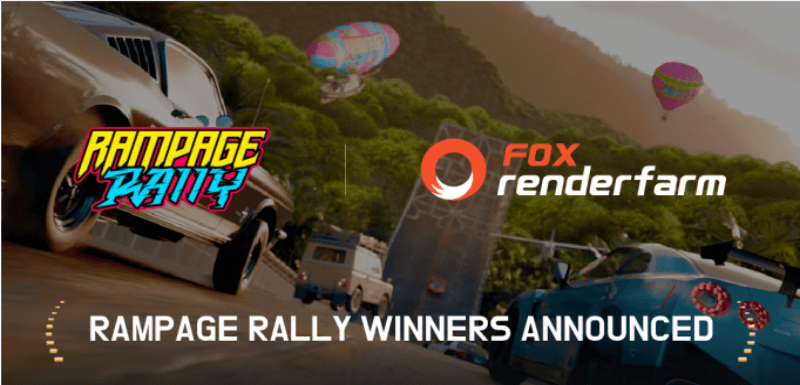
Meet Award-winning Art Director at AWS, Amaru Zeas
Trending
cloud rendering
FGT3D Hunter Challenge organized by the TPN-Accredited cloud rendering services provider, Fox Renderfarm, received lots of excellent entries! We are so glad to have an interview with Amaru Zeas, one of the Professional finalists, with his amazing artwork “LIFE HUNTER”.LIFE HUNTER © Amaru ZeasAmaru: Have you ever imagined what the Amazon Rainforest will be like in the year 2172? Gl

A Behind-the-Scenes Look at Chungkang College's Student Animations
Top News
animation works
In this interview, Fox Renderfarm connects with the winners of the 2024 CKAS (Chungkang Animation Showcase). The three student teams behind AWAKE, Fairy of Shampoo, and Golden Memories from Chungkang College of Cultural Industries share their journey from concept to completion. Along the way, they reflect on their creative processes, challenges, and the role Fox Renderfarm played in bringing their

Annecy 2025 Interview: Inside Ringling College Grad Fletcher Rainey’s 3D Workflow
Top News
Annecy Festival
After graduating from Ringling College of Art and Design’s Computer Animation Program, Fletcher (Ellie) Rainey shares first impressions of the animation scene and how Fox Renderfarm played a key role in supporting student projects. From easing tight render deadlines to providing cost-effective and accessible cloud rendering, Fletcher reflects on how Fox Renderfarm streamlined the rendering w

MIFA 2025 Interview: Wenming’s Creative Journey with Fox Renderfarm
Top News
Fox Renderfarm Interview
With a background in stage art and video post-production, Wenming completed her undergraduate studies in Hong Kong and earned a master’s degree in France. Her journey into 3D rendering began when she discovered Blender, and she started using Fox Renderfarm two years ago during a render challenge hosted by pwnisher. What began as a trial soon became an essential part of her creative workflow

1st Place in Chasm's Call: LescArt’s Winning 3D Workflow using Fox Renderfarm
Top News
Fox Renderfarm Interview
City Siege © LescArtWe are pleased to welcome Lennard Schmidt aka. LescArt, a talented 3D generalist from Northern Germany and the 1st Place winner of pwnisher’s Chasm’s Call Challenge. His stunning entry—a meticulously crafted medieval battle scene—stood out among thousands of submissions, showcasing his expertise in crowd simulation, environmental storytelling, and d

Social Commentary in 3D: How David Sujono Won 2nd Place in Chasm’s Call with ‘Offside’
Top News
Fox Renderfarm Interview
Offside © David SujonoWhen David Sujono’s “Offside” won 2nd place in Pwnisher’s Chasm’s Call Challenge, it wasn’t just the technical mastery that captivated audiences—it was also the story. Blending stunning 3D visuals with poignant social commentary, the piece masterfully explores themes of wealth disparity. In this exclusive interview with Fox Rende

Dragons, Lightning & a Top 3 Finish: Bipul Timsina’s Chasm’s Call Success
Top News
Fox Renderfarm Interview
In this exclusive interview with Fox Renderfarm, the industry’s top cloud rendering services provider and render farm, we chatted with Bipul Timsina, a talented 3D artist from Nepal. From his early days as a generalist to specializing in lighting, Bipul shares insights into his creative journey, his award-winning project "Wings of Storm," which won 3rd place in pwnisher’s Chasm’s

Inside Blender's Success: Exclusive Interview with COO Francesco Siddi
Top News
Blender
In an exclusive interview with Fox Renderfarm, the industry’s top cloud rendering services provider and render farm, Francesco Siddi, the COO of Blender and a visionary leader in open-source 3D innovation, shares his remarkable journey from discovering Blender as a teenager in a computer magazine to shaping its future as an industry-leading tool. He offers unique insights into Blender's comm

Anime Meets Realism: HoldimProvae on Winning 4th in the Chasm’s Call Challenge
Top News
pwnisher 3D Challenge
The Transfer © Kim ByeongJin / @HoldimProvaeKim ByeongJin, widely known online as HoldimProvae, is a real-time game VFX artist whose work blends technical precision with evocative narrative. After securing 4th place in pwnisher’s Chasm’s Call Challenge, Holdim joins Fox Renderfarm, the industry’s top cloud rendering services provider and render farm, to dissect his winning s

Chasm's Call Top 5: A Chat with LEGO Animator Tino Klein
Top News
pwnisher 3D Challenge
Tino Klein’s love for animation began at the age of 14 with a Lego Star Wars stop-motion film. Now, as a 3D artist, he blends nostalgia and technical skill to create playful LEGO animations. His latest work, “Trouble in LEGO Town”, earned 5th place in the Chasm’s Call Challenge by bringing a brick-built city to life. In this interview with Fox Renderfarm, the industry&rsquo

The Skyline We Shared: FasTK_Art’s Cyber City Challenge Win
Top News
Fox Renderfarm Interview
Meet FasTK_Art, the 19-year-old Mexican 3D artist whose passion for creation knows no bounds. Recently crowned the winner of Kaizen’s Cyber City Challenge, he has proven that age is no barrier to talent and innovation. In this exclusive interview, FasTK_Art opens up about his creative process, the tools he uses, and how he balances colour to bring this stunning vision to life. Join Fox Rende

Animating Dreams: The Bold Journey of Meukam Vallin
Top News
Fox Renderfarm Interview
Journey of the Legend © Vallin MeukamStep into a realm where creativity defies limits and legends are reborn in vibrant digital form. From the heart of Cameroon, MEUKAM VALLIN spearheads ILLUSION HOUSE—a spirited 3D animation and VFX studio that’s shaking up the scene with its innovative storytelling. As the creative force behind the animated short film Journey of the Legend, Vall


![5 Best Laptops for Rendering in 2025 [Powerful Devices]](http://static.rayvision.com/media/28_Top_picks_of_5_best_laptop_for_modeling_and_rendering_in_2025_333ddca798.png?w=1000&q=100)








